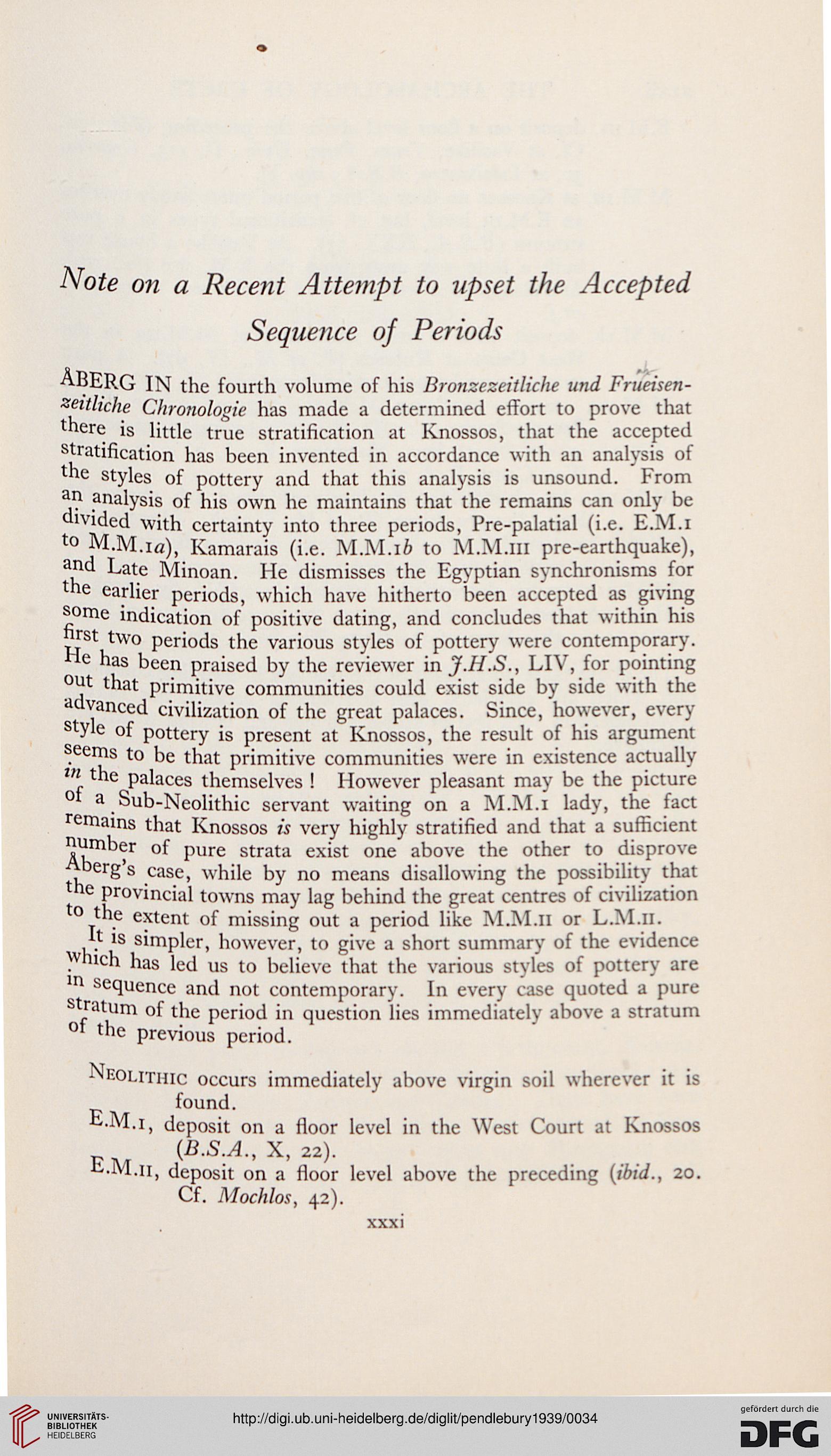Note on a Recent Attempt to upset the Accepted
Sequence of Periods
ABERG IN the fourth volume of his Bronxezeitliche und Frueisen-
zeitliche Chronologic has made a determined effort to prove that
there is little true stratification at Knossos, that the accepted
stratification has been invented in accordance with an analysis of
the styles of pottery and that this analysis is unsound. From
an analysis of his own he maintains that the remains can only be
divided with certainty into three periods, Pre-palatial (i.e. E.M.i
to M.M.ia), Kamarais (i.e. M.M.ifc to M.M.III pre-earthquake),
and Late Minoan. He dismisses the Egyptian synchronisms for
the earlier periods, which have hitherto been accepted as giving
some indication of positive dating, and concludes that within his
first two periods the various styles of pottery were contemporary.
He has been praised by the reviewer in J.H.S., LIV, for pointing
out that primitive communities could exist side by side with the
advanced civilization of the great palaces. Since, however, every
style of pottery is present at Knossos, the result of his argument
seems to be that primitive communities were in existence actually
*» the palaces themselves ! However pleasant may be the picture
°f a Sub-Neolithic servant waiting on a M.M.i lady, the fact
remains that Knossos is very highly stratified and that a sufficient
number of pure strata exist one above the other to disprove
Aberg's case, while by no means disallowing the possibility that
the provincial towns may lag behind the great centres of civilization
to the extent of missing out a period like M.M.n or L.M.n.
It is simpler, however, to give a short summary of the evidence
which has led us to believe that the various styles of pottery are
m sequence and not contemporary. In every case quoted a pure
stratum of the period in question lies immediately above a stratum
of the previous period.
Neolithic occurs immediately above virgin soil wherever it is
found.
E.M.I, deposit on a floor level in the West Court at Knossos
(B.S.A., X, 22).
E.M.II, deposit on a floor level above the preceding (ibid., 20.
Cf. Mochlos, 42).
Sequence of Periods
ABERG IN the fourth volume of his Bronxezeitliche und Frueisen-
zeitliche Chronologic has made a determined effort to prove that
there is little true stratification at Knossos, that the accepted
stratification has been invented in accordance with an analysis of
the styles of pottery and that this analysis is unsound. From
an analysis of his own he maintains that the remains can only be
divided with certainty into three periods, Pre-palatial (i.e. E.M.i
to M.M.ia), Kamarais (i.e. M.M.ifc to M.M.III pre-earthquake),
and Late Minoan. He dismisses the Egyptian synchronisms for
the earlier periods, which have hitherto been accepted as giving
some indication of positive dating, and concludes that within his
first two periods the various styles of pottery were contemporary.
He has been praised by the reviewer in J.H.S., LIV, for pointing
out that primitive communities could exist side by side with the
advanced civilization of the great palaces. Since, however, every
style of pottery is present at Knossos, the result of his argument
seems to be that primitive communities were in existence actually
*» the palaces themselves ! However pleasant may be the picture
°f a Sub-Neolithic servant waiting on a M.M.i lady, the fact
remains that Knossos is very highly stratified and that a sufficient
number of pure strata exist one above the other to disprove
Aberg's case, while by no means disallowing the possibility that
the provincial towns may lag behind the great centres of civilization
to the extent of missing out a period like M.M.n or L.M.n.
It is simpler, however, to give a short summary of the evidence
which has led us to believe that the various styles of pottery are
m sequence and not contemporary. In every case quoted a pure
stratum of the period in question lies immediately above a stratum
of the previous period.
Neolithic occurs immediately above virgin soil wherever it is
found.
E.M.I, deposit on a floor level in the West Court at Knossos
(B.S.A., X, 22).
E.M.II, deposit on a floor level above the preceding (ibid., 20.
Cf. Mochlos, 42).




